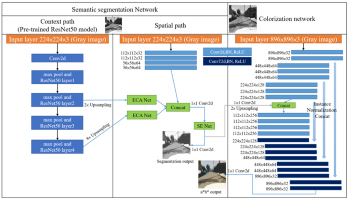References
1ChenT.WangY.SchillingsV.MeinelC.2004Grayscale image matting and colorizationProc. Asian Conf. Comput. Vis.116411691164–9SpringerJeju, Korea
2YatzivL.SapiroG.2006Fast image and video colorization using chrominance blendingIEEE Trans. Image Process.15112010.1109/TIP.2005.864231
3ChiaA. Y. S.ZhuoS.GuptaR. K.TaiY. W.ChoS. Y.TanP.LinS.2011Semantic colorization with internet imagesACM Trans. Graph.30110.1145/2070781.2024190
4CarlucciF. M.RussoP.CaputoB.2018(DE)2CO: deep depth colorizationIEEE Robot. Autom. Lett.3238610.1109/LRA.2018.2812225
5ChengZ.YangQ.ShengB.2015Deep colorizationProc. IEEE Int’l. Conf. Comput. Vis.415423415–23IEEEPiscataway, NJ10.1109/ICCV.2015.55
6HuZ.ShkuratO.KasnerM.2024Grayscale image colorization method based on U-net networkInt. J. Image, Graph. Signal Process.1670
7ZhangR.IsolaP.EfrosA. A.2016Colorful image colorizationProc. Eur. Conf. Comput. Vis.649666649–66SpringerAmsterdam, Netherlands10.1007/978-3-319-46487-9_40
8LarssonG.MaireM.ShakhnarovichG.2016Learning representations for automatic colorizationProc. Eur. Conf. Comput. Vis.577593577–93SpringerAmsterdam, Netherlands10.1007/978-3-319-46493-0_35
9IizukaS.Simo-SerraE.IshikawaH.2016Let there be color! Joint end-to-end learning of global and local image priors for automatic image colorization with simultaneous classificationACM Trans. Graph.351
10HeM.ChenD.LiaoJ.SanderP. V.YuanL.2018Deep exemplar-based colorizationACM Trans. Graph.371
11SangkloyP.LuJ.FangC.YuF.HaysJ.2017Scribbler: controlling deep image synthesis with sketch and colorProc. IEEE Conf. Comput. Vis. Pattern Recognit.540054095400–9IEEEPiscataway, NJ10.1109/CVPR.2017.723
12ZhangR.ZhuJ. Y.IsolaP.GengX.LinA. S.YuT.EfrosA. A.2017Real-time user-guided image colorization with learned deep priorsACM Trans. Graph.361
13XiaoY.ZhouP.ZhengY.LeungC. S.2019Interactive deep colorization using simultaneous global and local inputsProc. IEEE Int’l. Conf. Acoust., Speech, Signal Process188718911887–91IEEEPiscataway, NJ10.1109/ICASSP.2019.8683686
14CiY.MaX.WangZ.LiH.LuoZ.2018User-guided deep anime line art colorization with conditional adversarial networksProc. ACM Int’l. Conf. Multimedia153615441536–44ACMSeoul, Korea10.1145/3240508.3240661
15DeshpandeA.LuJ.YehM. C.ChongM. J.ForsythD.2017Learning diverse image colorizationProc. IEEE Conf. Comput. Vis. Pattern Recognit.683768456837–45IEEEPiscataway, NJ10.1109/CVPR.2017.307
16FransK.
17NazeriK.NgE.EbrahimiM.2018Image colorization using generative adversarial networksProc. Int’l. Conf. Articulated Motion and Deformable Objects859485–94SpringerPalma de Mallorca, Spain10.1007/978-3-319-94544-6_9
18VitoriaP.RaadL.BallesterC.2020ChromaGAN: adversarial picture colorization with semantic class distributionProc. IEEE Winter Conf. Appl. Comput. Vis.244524542445–54IEEEPiscataway, NJ10.1109/WACV45572.2020.9093389
19LiB.LuY.PangW.XuH.2023Image colorization using CycleGAN with semantic and spatial rationalityMultimed. Tools Appl.82110.1007/s11042-022-12047-3
20GuadarramaS.DahlR.BieberD.NorouziM.ShlensJ.MurphyK.2017PixColor: pixel recursive colorizationProc. Brit. Mach. Vis. Conf.1121–12BMVALondon, UK
21ZhaoJ.HanJ.ShaoL.SnoekC. G.2020Pixelated semantic colorizationInt. J. Comput. Vis.12881810.1007/s11263-019-01271-4
22ZhaoJ.LiuL.SnoekC.HanJ.ShaoL.2018Pixel-level semantics guided image colorizationProc. Brit. Mach. Vis. Conf.156BMVANewcastle, UK
23HeM.ChenD.LiaoJ.SanderP. V.YuanL.2018Deep exemplar-based colorizationACM Trans. Graph.3747
24SuJ. W.ChuH. K.HuangJ. B.2020Instance-aware image colorizationProc. IEEE Conf. Comput. Vis. Pattern Recognit.796879777968–77IEEEPiscataway, NJ10.1109/CVPR42600.2020.00799
25KumarM.WeissenbornD.KalchbrennerN.2021Colorization transformerProc. Int’l. Conf. Learn. Represent.ICLR, VirtualVienna, Austria
26WengS.SunJ.LiY.LiS.ShiB.2022CT2: colorization transformer via color tokensProc. Eur. Conf. Comput. Vis.1101–10SpringerTel Aviv, Israel10.1007/978-3-031-20071-7_1
27ShafiqH.LeeB.2024Transforming color: a novel image colorization methodElectronics13251110.3390/electronics13132511
28WangH.ChaiX.WangY.ZhangY.XieR.SongL.2024Multimodal semantic-aware automatic colorization with diffusion priorProc. IEEE Int’l. Conf. Multimedia Expo Workshops161–6IEEEPiscataway, NJ
29ZabariN.AzulayA.GorkorA.HalperinT.FriedO.2023Diffusing colors: image colorization with text guided diffusionProc. SIGGRAPH Asia Conf. Papers1111–11ACMSydney, Australia10.1145/3610548.3618180
30SuJ. W.ChuH. K.HuangJ. B.2020Instance-aware image colorizationProc. IEEE/CVF Conf. Comput. Vis. Pattern Recognit.796879777968–77IEEEPiscataway, NJ10.1109/CVPR42600.2020.00799
31AnwarS.TahirM.LiC.MianA.KhanF. S.MuzaffarA. W.2025Image colorization: a survey and datasetInf. Fusion11410272010.1016/j.inffus.2024.102720
32LiangZ.LiZ.ZhouS.LiC.LoyC. C.2025Control color: multimodal diffusion-based interactive image colorizationInt. J. Comput. Vis.
33GarcíaR.RandallG.RaadL.2024A short analysis of BigColor for image colorizationImage Process. Online1414410.5201/ipol.2024.542
34CordtsM.OmranM.RamosS.RehfeldT.EnzweilerM.Benenson, …R.SchieleB.2016The Cityscapes dataset for semantic urban scene understandingProc. IEEE Conf. Comput. Vis. Pattern Recognit.321332233213–23IEEEPiscataway, NJ10.1109/CVPR.2016.350
35NeuholdG.OllmannT.BuloS. R.KontschiederP.2017The Mapillary Vistas dataset for semantic understanding of street scenesProc. IEEE Int’l. Conf. Comput. Vis.499049994990–9IEEEPiscataway, NJ10.1109/ICCV.2017.534
36BajbaaK.UsmanM.AnwarS.RadwanI.BaisA.
37LiY.YangS.LiuJ.
38MaC.ShiZ.LuZ.XieS.ChaoF.SuiY.
39XuM.2025Image colorization based on transformerSci. Rep.152131110.1038/s41598-025-05485-0
40XuZ.GengC.2024Color restoration of mural images based on a reversible neural networkHeritage Sci.1235110.1186/s40494-024-01471-3
41YuC.GaoC.WangJ.YuG.ShenC.SangN.2021BiSeNet V2: bilateral network with guided aggregation for real-time semantic segmentationInt. J. Comput. Vis.129305110.1007/s11263-021-01515-2
42ZhaoH.ShiJ.QiX.WangX.JiaJ.2017Pyramid scene parsing networkProc. IEEE Conf. Comput. Vis. Pattern Recognit.288128902881–90IEEEPiscataway, NJ10.1109/CVPR.2017.660
43LinG.MilanA.ShenC.ReidI.2017RefineNet: multi-path refinement networks for high-resolution semantic segmentationProc. IEEE Conf. Comput. Vis. Pattern Recognit.192519341925–34IEEEPiscataway, NJ10.1109/CVPR.2017.549
44ChenL. C.ZhuY.PapandreouG.SchroffF.AdamH.2018Encoder-decoder with atrous separable convolution for semantic image segmentationProc. Eur. Conf. Comput. Vis.801818801–18SpringerMunich, Germany10.1007/978-3-030-01234-2_49
45RonnebergerO.FischerP.BroxT.2015U-net: convolutional networks for biomedical image segmentationProc. Med. Image Comput. Comput.-Assist. Interv. (MICCAI)234241234–41SpringerMunich, Germany10.1007/978-3-319-24574-4_28
46WangQ.WuB.ZhuP.LiP.ZuoW.HuQ.2020ECA-Net: efficient channel attention for deep convolutional neural networksProc. IEEE Conf. Comput. Vis. Pattern Recognit.115341154211534–42IEEEPiscataway, NJ10.1109/CVPR42600.2020.01155
47HuJ.ShenL.AlbanieS.SunG.WuE.2018Squeeze-and-excitation networksProc. IEEE Conf. Comput. Vis. Pattern Recognit.713271417132–41IEEEPiscataway, NJ10.1109/TPAMI.2019.2913372
48LeCunY.BottouL.BengioY.HaffnerP.1998Gradient-based learning applied to document recognitionProc. IEEE86227810.1109/5.726791
49ZeilerM. D.TaylorG. W.FergusR.2011Adaptive deconvolutional networks for mid and high-level feature learningProc. IEEE Int’l. Conf. Comput. Vis.201820252018–25IEEEPiscataway, NJ10.1109/ICCV.2011.6126474
50IoffeS.SzegedyC.2015Batch normalization: accelerating deep network training by reducing internal covariate shiftProc. Int’l. Conf. Mach. Learn.448456448–56PMLRLille, France
51GlorotX.BordesA.BengioY.2011Deep sparse rectifier neural networksProc. Int’l. Conf. Artif. Intell. Stat.770778770–8JMLRFort Lauderdale, FL, USA
52
53HeK.ZhangX.RenS.SunJ.2016Deep residual learning for image recognitionProc. IEEE Conf. Comput. Vis. Pattern Recognit.770778770–8IEEEPiscataway, NJ10.1109/CVPR.2016.90
54HanJ.MoragaC.1995The influence of the sigmoid function parameters on the speed of backpropagation learningProc. Int’l. Workshop Artif. Neural Netw.195201195–201SpringerSitges, Spain10.1007/3-540-59497-3_175
55BridleJ. S.1990Probabilistic interpretation of feedforward classification network outputs, with relationships to statistical pattern recognitionNeurocomputing68227
56UlyanovD.VedaldiA.LempitskyV.
57ZeilerM. D.
58UrozJ.LuoR.MorovicJ.MacDonaldL.LuoM. R.2002Perception of colour differences in large printed imagesColour Image Science: Exploiting Digital Media497349–73John Wiley & SonsChichester, UK
59LiC. J.LiZ. Q.WangZ. F.XuY.LuoM. R.CuiG. H.MelgosaM.BrillH.PointerM.2017Comprehensive color solutions: CAM16, CAT16, and CAM16-UCSColor Res. Appl.4270310.1002/col.22131
60RadfordA.KimJ. W.HallacyC.RameshA.GohG.AgarwalS.SastryG.AskellA.MishkinP.ClarkJ.KruegerG.SutskeverI.2021Learning transferable visual models from natural language supervisionProc. Int’l. Conf. Mach. Learn.874887638748–63PMLRVienna, Austria
61YuF.ChenH.WangX.XianW.ChenY.MuF.KoltunV.DarrellT.

 Find this author on Google Scholar
Find this author on Google Scholar Find this author on PubMed
Find this author on PubMed
 Open access
Open access